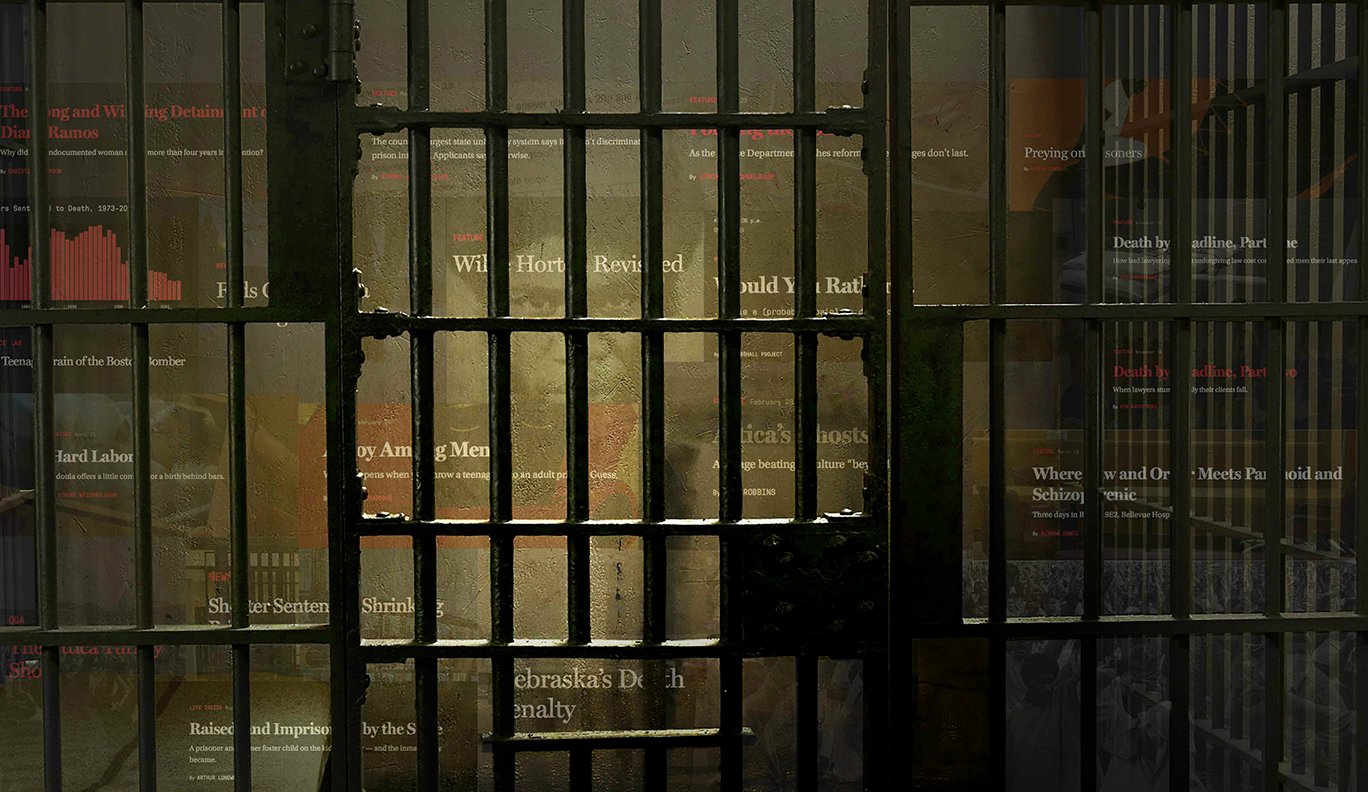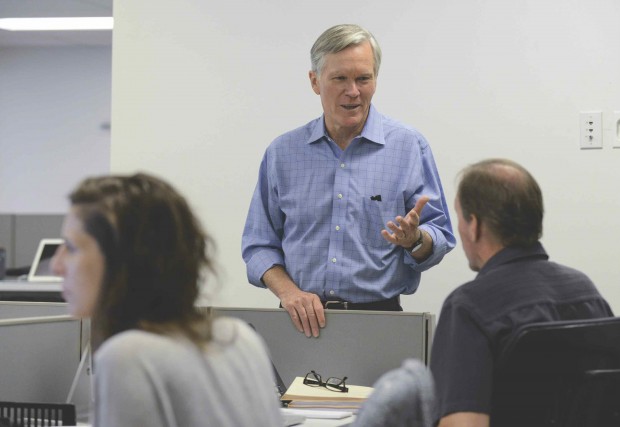 IT’S A CHILLY MARCH morning in Manhattan—the kind of grey, slushy Wednesday that can make even the most optimistic New Yorker wonder if winter will ever end. But for Bill Keller ’70, it might as well be spring.
IT’S A CHILLY MARCH morning in Manhattan—the kind of grey, slushy Wednesday that can make even the most optimistic New Yorker wonder if winter will ever end. But for Bill Keller ’70, it might as well be spring.
The previous weekend, Keller’s former employer, The New York Times, ran a 7,500-word article about the brutal beating in 2011 of an inmate by guards at the Attica Correctional Facility in upstate New York. Three of the guards were scheduled to stand trial on Monday for multiple felonies, including first-degree gang assault. All had rejected plea bargains.
The story was reported by investigative journalist Tom Robbins for The Marshall Project, the nonprofit digital news outlet dedicated to criminal justice issues that Keller has edited since it launched in November of last year; and it was posted to the Times and Marshall Project websites before appearing on the front page of the newspaper’s Sunday print edition, complete with striking photos by Times photographers Chang Lee and Damon Winter. (Keller, who has been a trustee of the College since 2000, says he spent “a lot of time” dashing in and out of a board meeting in Claremont the previous Friday, shepherding the piece through publication.) On Tuesday, Robbins and Times reporter Lauren D’Avolio filed another story: all three guards had suddenly accepted a deal from prosecutors, pleading guilty to a single misdemeanor and quitting their jobs in order to avoid jail time.
From a purely journalistic perspective, the two articles packed quite a wallop, reverberating across the Internet and stimulating commentary in a variety of other media. And it’s not inconceivable that the first, lengthy story helped create the environment that made the second, shorter one come to pass; maybe, Keller mused in his Midtown office, a series of masks representing former Russian leaders gazing down at him from the wall, the guards decided to accept a plea deal because the weekend feature made it clear that prosecutors had a strong case against them.
The Marshall Project was founded by Neil Barsky, a former Wall Street Journal reporter, documentary filmmaker, and hedge-fund manager whose interest in criminal justice was piqued a couple of years ago by two books: Michelle Alexander’s The New Jim Crow, which examines the mass incarceration of African Americans; and Gilbert King’s Devil in the Grove, about Thurgood Marshall’s defense of four young black men who were falsely accused in 1949 of raping a white woman. (The Marshall Project was named for the late Supreme Court justice.) Barsky was raised in a politically active household—both parents were involved in the civil rights movement—and he retains a belief in the power of journalism to effect social change. He also feels that the American public has become inured to the fact that the nation’s criminal justice system is, as he says, “scandalously messed up.” So he decided to use digital journalism to lend the subject of criminal justice reform the urgency it deserves. “The status quo is not defensible,” Barsky says. “The country needs to see this issue like the house is on fire.”
Barsky didn’t know Keller personally, but in June 2014, he shot him an email to see if he might be interested in signing on as editor-in-chief. The two met for breakfast; Keller agreed; and then, as Barsky puts it, “all hell broke loose.”
“Bill’s hiring put us on the map right away with funders and with other reporters and editors who wanted to work with us,” Barsky says. It also stirred up a great deal of media attention, with articles about Keller, Barsky and The Marshall Project appearing long before the site actually launched.
This should come as no surprise. Keller is one of the most familiar and respected figures in American print journalism: Over the course of his 30 years at the Times, he won a Pulitzer for his coverage of the fall of the Soviet Union; served as bureau chief in South Africa during the end of apartheid; held the position of executive editor for eight years; and ended his run at the paper as a columnist. His decision to move to a nonprofit digital enterprise evoked comparisons with Paul Steiger, who left his job as managing editor of the Wall Street Journal to found ProPublica, now the largest and best-known nonprofit digital newsroom in the country; and it generated a commensurate amount of buzz.
For Keller, running an editorial staff of 20 after several years of solitary column writing represented a welcome return to what he calls the “adrenaline and collegiality” of chasing news. Just as importantly, it meant working in an area where there was a real opportunity to effect change—there is broad bipartisan support for criminal justice reform these days—and to practice accountability journalism, probing public institutions to see if they are fulfilling their responsibilities. This, he adds, is distinct from advocacy: The Marshall Project does not promote specific legislative reforms, nor does it take a moral stand on issues like drug policy or capital punishment. (He does admit, however, that walking the line between advocacy and accountability can sometimes be uncomfortable, and says that he must occasionally keep his staff from crossing it; but as Supreme Court Justice Potter Stewart once memorably said of pornography, Keller claims to know advocacy when he sees it.)

Bill Keller ’70 at the New York office of the Marshall Project
There was also, Keller says, a certain appeal to building an organization from scratch, without the ample safety net afforded by The New York Times, and in managing a relatively small operation. “I can talk to pretty much everyone on my staff if I want to, which is nice,” Keller says—and presumably quite different from the Times, where he edited a staff of 1,250.
In fact, Keller had just come from The Marshall Project’s weekly editorial meeting. A clutch of reporters and editors crowded into Barsky’s office in his absence, some sitting on the floor, others taking up positions on top of a low-slung filing cabinet. Keller presided with genial authority, asking questions, soliciting opinions, and sifting the criminal justice news of the day for potential stories.
That news, as anyone with eyes to see or ears to hear can attest, has been coming thick and fast of late. The Marshall Project was conceived before Eric Garner died while being subdued by police officers in New York City; before Michael Brown and Walter Scott were fatally shot by police officers in Ferguson, Mo., and North Charleston, S.C.; and before Freddie Gray died of injuries sustained while in police custody in Baltimore. And it came into being as those and similar events sparked what has been described as the most significant American civil rights movement of the 21st century, inspiring a concomitant deluge of stories about crime, punishment and America’s failure to manage either one particularly well.
But criminal justice has always represented an unusually rich vein of material for investigative journalists, and that, too, appealed to Keller. The sheer scope of the topic was evident at the Wednesday meeting: Andrew Cohen, who edits “Opening Statement,” the site’s morning e-newsletter, talked about the release of a report by the President’s Task Force on 21st Century Policing; news editor Raha Naddaf described a possible collaboration with a highly regarded print magazine on deteriorating conditions at New York City’s Rikers Island jail complex; and Keller brought up the case of the Kettles Fall Five, a group of medical marijuana growers in Washington State who face federal drug charges. There was talk of immigration law, of data-driven reporting, and of recent revelations regarding just what kinds of information federal prosecutors are obliged to share with defense attorneys.
Several of those stories would make their way onto the site over the next month or so, as would a dizzying array of others. Indeed, in a single week in late April, The Marshall Project ran pieces that dissected the career of Baltimore police commissioner Anthony Batts; examined the treatment of transgender inmates and investigated standards of care for diabetic ones; considered the miserable record of the FBI’s forensics labs and the long-term efficacy of reforms imposed on local police forces by the Department of Justice; and invited readers to take a quiz to find out which are killed more humanely: pets or prisoners. (Answer: pets.) “For a niche subject, this is a very big niche,” says Keller, who together with staff writer Beth Schwartzapfel filed a story in mid-May about Willie Horton, the convicted murderer and rapist whom George H.W. Bush used to pummel Michael Dukakis in the 1988 presidential election.
Much of the site’s original reporting covers topics that remain underreported elsewhere, or provides added context to ones that are already trending. There’s no denying that the latter have proliferated wildly over the past year or so: “Opening Statement” typically includes links to pieces produced not only by other criminal justice outlets like The Crime Report and The Juvenile Justice Information Exchange, but also by publications such as The New Yorker, The Atlantic, The Guardian; a host of independent blogs and progressive news sites; and just about every major newspaper in the United States.
The attention currently being paid to criminal justice represents a sharp reversal following years of declining coverage. That decline, says Stephen Handelman, who edits The Crime Report and directs the Center on Media, Crime and Justice at John Jay College of Criminal Justice, resulted from two principal phenomena: falling crime rates, which made the topic a “spectator sport” for many middle-class Americans; and turmoil in the news business, which led to a reduction in resources, including the number of reporters with the knowledge and experience required to tackle complex criminal justice stories. Despite the proliferation of digital tools for gathering and distributing news and information, solid investigative reporting still requires old-fashioned shoe-leather, which in turn requires both time and its correlate, money. And investigative reporting that focuses on criminal justice stories that may unfold over weeks or months or even years—stories that require reporters to scrutinize sprawling institutions like the federal court system or state correctional facilities and that involve untangling the complex web of legal, social and political factors at play in issues like the mass incarceration of black men, the detention of undocumented immigrants, the war on drugs and the use of prisons as holding pens for the mentally ill—requires a lot of both.
Which brings us, inevitably, to the “nonprofit” part of “nonprofit digital news outlet.” The word is by no means a synonym for impoverished; some of the most robust news organizations in the country (NPR, The Associated Press) are nonprofits. Nonetheless, there are concerns about the long-term prospects of the smaller digital nonprofits that sprouted like mushrooms in the wake of the Great Recession, when the short-term prospects of traditional news media appeared to be particularly dismal. A 2013 study of 172 nonprofit digital news outlets by the Pew Research Center suggested a guardedly optimistic attitude, with most reporting that they were in the black. But the study also found that many of those same outlets were reliant on one-time seed grants from foundations, and lacked sufficient resources to pursue the marketing and fundraising activities that could help them become more financially stable. “Nonprofit journalism isn’t going away any time soon,” says Jesse Holcomb, a senior researcher at the center who worked on the report. “But that doesn’t mean there’s been a tipping point in terms of achieving a sustainable approach.”
Research by the Knight Foundation indicates that the most successful nonprofit news organizations seek to diversify their funding; invest in marketing, business development and fundraising; and build partnerships with other organizations to expand their audiences and bolster their brands. Judging by those criteria, The Marshall Project appears to be on solid footing. The site has a long list of donors, some of whom have committed funds for two or three years, and a dedicated business staff. Keller and Barsky are considering a wide range of alternative revenue sources, including memberships, conferences, and sponsorships—though advertising might be a tougher row to hoe. (“Advertisers aren’t dying to advertise their products next to stories about prison rape,” Keller says.) And thanks no doubt in part to the Keller Effect, the site is not hurting for partners.
In addition to the Attica piece, The Marshall Project has published stories in conjunction with The Washington Post, The Chronicle of Higher Education, and Vice, which Keller describes as “a direct pipeline to a younger audience.” It also has projects in the works with 60 Minutes and This American Life, and is in talks with several other outlets, including Stars and Stripes, The Weather Channel, and the statistics-driven news site 538.org.
In some ways, Keller says, it’s easier to do everything yourself. But collaborations with other outlets help build the site’s credibility, and allow it to leverage the resources of different organizations. (The Times, for example, contributed photography to the Attica piece, which can be costly, while other partners might provide legal services or help cover travel expenses.) Most importantly, such partnerships ensure that The Marshall Project’s reporting, which Keller describes as “journalism with a purpose,” will reach the largest possible audience.
“The aim,” says Keller, “is to get these issues onto the larger stage. And for that, you need a megaphone.”

